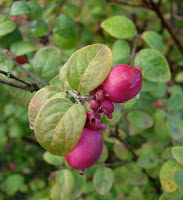When planting, it's important to create layers of plantings within the landscape. Avoid pruning shrubs too tightly; birds prefer crevices for shelter and protection. Plants with berries provide an excellent source of food as well, especially during winter when resources can be more scarce. In spring, keep your eye out for birds' nests! A dense, stratified, landscape makes an excellent spot for birds to raise their young.
1. Bearberry
(Arctostaphylos uva- ursi 'Massachusetts')
| An outstanding, sturdy, evergreen ground cover. The light pinkish -white, urn shaped flowers in spring are followed by red berries, which can persist into winter. Leaves are small and dark green, and in the fall have a hint of red-gold. Read more...... |
(Viburnum tinus 'Spring Bouquet')
| Evergreen, dense, compact shrub with small, dark green foliage. Lightly fragrant pinkish-white flowers cover the foliage in the spring, originally opening from red buds. Flowers are followed by blue-black fruit. Excellent choice for a compact hedge or screen. Read more...... |
(Lonicera nitida 'Baggesens Gold')
| An evergreen, unique broad growing shrub, with dense, small leaves. Gold color will hold truer in cold climates, and when given some shade. |
4. Pacific Wax Myrtle
(Myrica californica)
| Evergreen, dense, bushy shrub with clean, glossy green leaves throughout the year held on mostly upright stems. Small flowers form before new leaves appear and are followed by purple nutlet fruits. Fruits are attractive to birds and wax can be rendered from them. Tolerates poor soil, damp soil, summer drought and survives high winds. This is native to the Pacific Coast and coastal valleys from Washington state to southern California, and is considered one of the most attractive natives in the landscape setting. Use as a specimen or hedging plant. Read more...... |
5. Magic Berry Snowberry
(Symphoricarpos x doorenbosii 'Magic Berry')
| Profusion of delicate pink flowers in late summer. Masses of vivid pinkish-purple fruit line each branch in autumn. Persistent pink fruit in fall matures to a deep wine color. Compact, gracefully arching plant with a sturdy habit. The fruiting stems can last up to two weeks in floral arrangements |
| Read more...... |
6. Salal (Gaultheria shallon)
| Evergreen, Pacific Northwest native shrub and groundcover. Leaf-stalks, flower stems, bracts, and young branches are reddish and bristly. Pinkish white, pendulous flowers are typically heather-bell shaped and appear from May to June, followed by bunches of dark purple berries. Can get taller in shady conditions. Read more...... |
7. Karl Foerster Feather Reed Grass
(Calamagrostis x acutiflora 'Karl Foerster')
Herbaceous perennial grass with erect clumps of green blades that are topped with flower panicles up to 15" long starting in the early summer. Flowers are pinkish green, turning to straw colored, and maintain ornamental value until late winter. Read more...
(Cornus sericea 'Baileyi')
| An upright, rounded shrub with red stems in the winter. White flowers in late spring are followed by bluish-white berries. Green foliage turns to reddish-purple in the fall. Read more...... |
9. Parney Cotoneaster (Cotoneaster lacteus)
| Evergreen shrub with white flowers in late spring that turn into lovely clusters of red berries in the fall. Read more...... |
10. Kasan Scarlet Firethorn
(Pyracantha coccinea 'Kasan')
| Beautiful evergreen shrub producing an abundance of orange-red berries in the fall on dense branches. Great for fall and winter color. Read more...... |
For more information, check out our full list of Plants that Attract Birds.












No comments:
Post a Comment